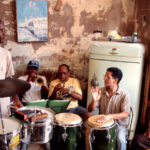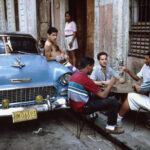Katherine Gordy
 THE CUBAN REVOLUTION S 50th anniversary has sparked academic conferences, debates and articles assessing its past and future.(1) How and why has the revolution survived? What does the future hold for Cuba? Or, as it is often put, more crudely, what will happen when Fidel/Raul dies?
THE CUBAN REVOLUTION S 50th anniversary has sparked academic conferences, debates and articles assessing its past and future.(1) How and why has the revolution survived? What does the future hold for Cuba? Or, as it is often put, more crudely, what will happen when Fidel/Raul dies?
My responses to these questions have always been short. The Cuban revolution has survived much as any established system survives, through a combination of coercion and consent.(2) The future holds gradual change, again, much as in any system that has been successfully institutionalized.
The questions assume that without Fidel Castro, or his doppelganger brother, there would be no Cuban revolution. They also assume that nothing ever changes in Cuba until crisis forces it. The language of crisis pervades contemporary treatments of Cuba in the United States. Academic and journalistic analyses often argue that the Cuban state prefers this perpetual state of crisis, since it allows it to wield power.
Cuba, by these accounts, is in crisis because Raul has dismissed vice-president Carlos Lage and foreign minister Felipe Perez Roque. It was in crisis because Fidel Castro was ill, Raul had taken over, the Soviet trading block had disappeared, or the dollar had been legalized. Each crisis was supposed to be the beginning of the end. Each time that Cuba pulled through only bolstered Colin Powell s claim, issued after the 2003 arrest of 75 dissidents, that Cuba was an aberration in the West. (3)
But what makes Cuba unique is not, as Powell suggested, infringements on civil liberties or human rights (including the use of capital punishment, which the United States uses with abandon). What distinguishes Cuba from the United States is that in Cuba, ideology and pragmatism are constantly being held in tension. Ideology isn t a dirty word used to dismiss one s opponents. Pragmatism is always couched in ideological terms, and those ideological terms are rooted in history and in practice. The cycle of dream followed by disappointment is one that Cubans are used to.

Socio-economic equality, unified leadership and inclusive nationalism were fundamental aspirations in 19th century debates on annexation, slavery, independence and the nature of the Cuban Republic. The compromising of Cuban independence, most poignantly illustrated in the passing of the Platt Amendment (1902) following the Spanish-American war, was a shock to those who had long struggled for it.The term shock suggests a dramatically different interpretation of Cuban history. Shock recognizes important moments in Cuban history as times of re-evaluation rather than rejection of the past and an embrace of post-crisis normality. In Cuba as elsewhere, crisis may force dramatic change, but the history of the Cuban revolution is one of constant adjustment. The revolution is ready to outlast not just Fidel Castro, but Raul as well.
From Fidel s to Raul s Cuba Observers tend to see Raul as more pragmatic than Fidel, yet such distinctions between hardliners and reformers within the party are rarely useful. Both Castro brothers combine pragmatism and ideology. They would not have been so successful at staying in power were this not the case. within the party who are seeking reforms are motivated by pragmatic and ideological concerns, as are those opposing them. Raul is considered a hardliner, yet he is more concerned with the institutionalization process than Fidel, who tended to oppose in principle various market-oriented policies adopted in 1990s or treat them as temporary measures in light of exceptional circumstances.
If Raul is a hardliner, he is one who believes that new policies, and especially those that appear to mark a change in course, should be considered carefully and introduced with clear guidelines. Laws that are introduced as stopgap measures, as the experience of the 1990s has shown, are laws that few understand and few take seriously.
Raul s style of leadership involves more power sharing and consultation, both with other top party officials and with those below. He is not the only one running the show, although he is still at liberty to dismiss such important government officials as Carlos Lage and Perez-Roque, who were considered members of the Fidel camp and resistant to the institutionalization process.
Unless increased reliance on the market is accompanied by greater popular participation, some worry Cuba will wind up looking like China or Vietnam, with state-run market economies and little or no popular participation. In 2006, Cuban literary critic Desiderio Navarro voiced concern that neo-Stalinist elements might try to take over the power vacuum left by Fidel Castro.(4)
Critics on the left have also argued that pre-revolutionary class divisions in Cuba, obscured in the early years of the revolution, are re-emerging. Their argument shares a striking similarity with the argument that the radicalization of Cuban Revolution in the beginning of the 1960s was a betrayal of the popular reformist movement of middle-class professionals (July 26th Movement) that brought Castro to power.
Many of this movement s members left the country and this export of dissent has been an important element in the consolidation of the revolution. Many on the Cuban Left also departed. They felt betrayed, and still do, by the revolution s centralization of power and the narrowing of realms in which workers, black Cubans, farmers, and others whose interests the revolution claimed to defend could organize themselves.
 These critics ignore the transformative nature of the revolutionary process. The revolution has created its own adherents from different classes in Cuban society through a variety of campaigns aimed either at bringing middle-class professionals into the fold (the literacy campaign, for instance) or improving the lot of the large number of people who did not share Cuba s prosperity in the first half of the 20th century. Middle-class converts became some of the strongest believers.
These critics ignore the transformative nature of the revolutionary process. The revolution has created its own adherents from different classes in Cuban society through a variety of campaigns aimed either at bringing middle-class professionals into the fold (the literacy campaign, for instance) or improving the lot of the large number of people who did not share Cuba s prosperity in the first half of the 20th century. Middle-class converts became some of the strongest believers.
By the 1990s, Cuba s professionals had a variety of pre-revolutionary class backgrounds. The dollar economy created new class divisions that at times coincided with older divisions (people with pre-revolutionary middle-class backgrounds might be more likely to have family abroad from whom they could receive remittances, while black and mulatto Cubans were less likely to have those networks), and at times didn t (professionals, regardless of class background, were some of the hardest hit, were less likely to work in the dollar economy and are often supporters of the revolution).
Marketization: Who Benefits?
The class that does seem to be in the best position to benefit from the incipient market shock is the military, which is responsible for most of the foreign investment and joint ventures in Cuba.
Starting in the 1990s (long before Raul, a career military man, took over), the military became heavily involved in the market economy when the government cut military spending. It is the military s economic model of firm autonomy and hard budgets that is being introduced into the larger economy in the form of the Sistema Perfeccionamiento Empresarial (the System of Enterprise Improvement).
Raul admires the Chinese model, but is aware that Cubans would not tolerate the levels of inequality associated with this or the Vietnamese model. Such inequality would challenge the legitimacy of the revolutionary leadership, which has always attempted to balance growth with equity, and usually privileged the latter.
There is still reason for concern that increasing marketization of the Cuban economy may not be accompanied by greater political opening, so that those who are not among the new elites will remain marginalized.(5) However, this new elite is in part a creation of the revolution and not a class that was sitting in deep freeze for almost 50 years waiting for the right moment to make their move.
Many of these elites are advocating for more popular participation. For instance, Raul s daughter Mariela Castro Esp n is director of the Cuban National Center for Sex Education in Havana and a LGBT activist. While not part of the Central Committee, she has pushed for a participatory socialism in Cuba, arguing that this is the most effective way to preserve the socialist achievements of the revolution in the 21st century.(6) Ironically, this was the position of many academics at the Center for the Study of the Americas, which was disbanded in 1995 and its members repremanded in a speech by Raul Castro. Yet critical intellectuals do not identify as dissidents, in spite of such characterizations from abroad and occasionally by the Cuban leadership, and instead insist upon their particular role in the Cuban revolution as organic intellectuals whose loyalty lies with the principles of Cuban socialism.
The dissident movement in Cuba is disorganized and easily discredited by links, both real and fabricated, with the United States. While dissident groups are not all allied with the United States and do not always support U.S. policy toward Cuba nor free market capitalism, their voices are shut out by the war of words between the U.S. and Cuban government.
New Demands
Challenges come from elsewhere, including from those who grew up with the revolution. They don t remember the days of Batista when Cuba was a country of extreme wealth and extreme poverty, but they do remember the 1980s when the Cuban standard of living was something to envy and when Cuba was an important international player. They expect more, and yet their values are shaped by revolutionary ideology.
Another important venue for critique is in the arts. Hip-hop and nueva trova serve as vehicles to raise issues of race and class in Cuba. Literature provides a view of the rough side of Cuban life.
Students have begun making demands. They want their education to mean something. Last year students at the University of Havana met with the president of the National Assembly, Ricardo Alarcon, and complained about inequality, the privileging of foreigners, the dual currency, and the low purchasing power of the Cuban peso.
It is true that there is great frustration in Cuba. After surviving the collapse of the Soviet Union and a period of extraordinary hardship in Cuba, things seemed to be getting better in the late 1990s and early 2000s, only to slip back again. Changes, such as last year s legalization of cell phone use and the lifting of laws that restricted Cuban access to tourist hotels, are ones that few Cubans can really take advantage of. Many young people, and particularly professionals, are leaving Cuba.
As a consequence, one of Cuba s major challenges is to make use of its highly educated population and avoid brain drain. One way to do that has been through medical missions, which allow Cuban doctors to work abroad and earn a much higher salary than they otherwise would at home.
In some cases, exchanges work in favor of Cuba s larger economy. For example, Venezuela sells oil to Cuba at discounted prices while Cuba sends doctors to Venezuela.
Other issues include: the construction of new housing, as a chronic housing shortage forces generations to live together; the re-evaluation of the Cuban peso to boost its purchasing power and diminish the gap between wage earners and those with access to remittances or the tourist industry; and pursuing ecotourism as a way to capture hard currency without the negative social and environmental effects associated with tourism in the Caribbean and in Cuba.
Finally, another major concern has been with increasing production, particularly in the agricultural sector. The country spends roughly $2 billion annually on food imports. One quarter of that is paid for in cash to U.S. agribusiness. Two-thirds of food production in Cuba comes from private farmers who control only a small fraction of the farmland.
The government has handed over fallow, but arable, land to small farmers and made other increases in material incentives in order to improve production.
Cuba has not always been able to balance growth with equity, but perhaps its greatest legacy is that it has always tried and never allowed itself to lose sight of the latter. Its other legacy may that the politicization of all spheres of Cuban life can feel burdensome to Cubans, but can also spill out beyond control in ways that cannot fit easily into categories of dissidence or party dogmatism.

